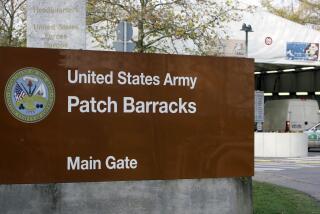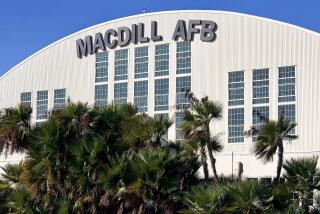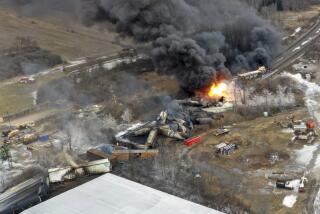Military Security Issues Hits Home
- Share via
WASHINGTON — In April, someone stole machines used to make military identification cards from an Army building in Washington. In May, it was plastic explosives and land mines from a Navy base in California.
Although American military posts overseas get the lion’s share of the attention and money to fight off possible terrorist attacks, officials are taking a closer look at how secure stateside bases are as well.
Commanders from coast to coast say they need more people and money to protect troops and their families from what some believe is an inevitable attack on U.S. soil.
“In the battle for anti-terrorism dollars, it is difficult for stateside bases to compete,” said Brig. Gen. Thomas P. Kane of the 60th Air Mobility Wing at Travis Air Force Base in California.
“We can’t afford to sit on our hands and wait to see if one of our domestic bases is attacked, and then face the issue,” said Rep. Jim Turner (D-Texas), a member of the House Armed Services Committee.
“Numerous potential vulnerabilities” at U.S. bases have been found in a General Accounting Office study commissioned by the committee’s Special Oversight Panel on Terrorism and due to be completed this summer, lawmakers said.
At a recent closed-door session, GAO researchers reportedly told panel members preliminarily that most of the problems could be fixed without more money, but rather with changes in how troops operate.
The study was requested after October’s bombing of the USS Cole in Yemen, an attack that killed 17 sailors and nearly sunk the warship.
The GAO, Congress’ investigative arm, studied 11 American bases, most city-like places that house many thousands of people and include schools, hospitals, weapons storage facilities, training ranges and so on.
Kane, appearing with commanders from four such bases, told the oversight panel last week that much already has been done.
Additional guard gates have been built, computer systems bolstered against cyber attacks and visitor passes instituted at bases that previously allowed people to come and go unchecked, he said.
The commanders all said more needs to be done.
“Without adequate funding . . . any efforts we attempt to make toward anti-terrorism force protection are Band-Aids on a catastrophic wound,” said Maj. Gen. David F. Bice, newly arrived at the Marine Corps’ Camp Pendleton.
His 125,000-square-acre base has 17 miles of open Pacific coastline and is 60 miles from the Mexican border. About 100,000 people use the post, and 62,000 cars enter its gates daily.
The biggest challenge, Bice said, is that base facilities were not built to today’s anti-terrorism standards; 40% were built in the 1940s and ‘50s.
The Norfolk, Va., Naval Station has a new security fence with roving patrols, more than doubled its harbor patrols, and installed a float line to mark perimeters around piers so it can more easily spot and stop unauthorized boats approaching the piers.
Norfolk is home to 77 ships and 138 aircraft and has 14 miles of shoreline. Its commander, Capt. Joseph F. Bouchard, said he needs more military and civilian police to help, as well as more money.
In San Diego, Capt. Leendert R. Hering plans to devote one day in July to anti-terrorism training.
“Attitudes and perceptions must also change,” Hering said in a written statement, adding that headway already has been made. “An open gate means something different today than it did six months ago,” he said.
No total was available for security upgrades sought at all the bases, although lawmakers said it would be in the billions of dollars.
Army Col. Addison D. Davis of Ft. Bragg, N.C., said budgets for anti-terrorism programs have been declining since 1999.
Ft. Bragg is an open base with unrestricted vehicle access, three state highways running through it, 11 miles of railroad, 8 schools, 11 churches and 11 shopping centers.
This year, the base got $144,000 out of $910,000 it wanted for anti-terrorism efforts, Davis said. It got $449,000 in 1999.
More to Read
Sign up for Essential California
The most important California stories and recommendations in your inbox every morning.
You may occasionally receive promotional content from the Los Angeles Times.













